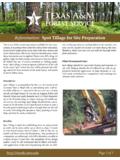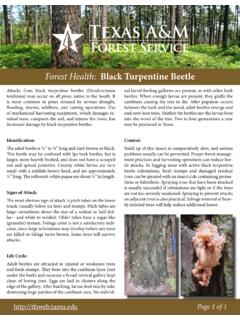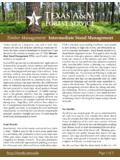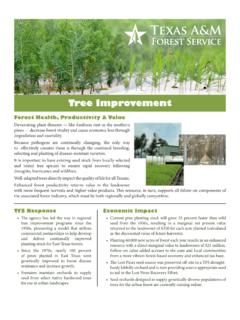Transcription of Technical Tree Solutions: Vertical …
1 Vertical mulching / composting is a soil treatment conducted around a tree s root system that improves root function and tree health by aerating compacted soil, adding nutrients to poor soil, and increasing water infiltration. Plugs of existing soil are removed in a radial pattern around the tree trunk and replaced with compost, mulch, gravel, or sand. It is usually conducted when the tree shows signs of stress such as branch dieback and the cause has been diagnosed as soil compaction. It can also be done in poor soils, such as soils with high sand content, where trees have shown little to no growth since planted as a result of a lack of nutrients. Another situation where it may be advantageous is when sod has been laid across the top of the tree s root system, inhibiting water infiltration and oxygen uptake.
2 Determining what material with which to backfill the holes depends on the reason for the treatment. Mulch, sand or gravel are advised when the goal is just to aerate the soil and increase water infiltration. Compost should be used when the goal is also to increase nutrients. If the site is heavily used by pedestrians, and there is a risk of someone stepping in one of the holes, gravel and sand may avoid injuries. Mulch and compost can break down over time and leave a depression in the landscape, which could cause a tripping hazard. A temporary barrier can also be placed around the tree until the soil has had time to settle and the depressions have been filled in. Page 1 of 2 Technical Tree Solutions: Vertical mulching / composting Vertical mulching / composting should be done in the winter months when trees are dormant so that disturbing the fine roots will not impact the health of the tree during the growing season.
3 Fine roots quickly regrow when cut. When conducting the treatment, never cut through large roots. If a large root is detected during the soil excavation process, simply move over a few inches and dig another hole. The treatment may need to be repeated 2-3 years in a row, excavating different locations each time, to greatly improve the health of the tree. See diagram on page two of the Vertical mulching / composting process. Technical Tree Solutions: Vertical mulching / composting Page 2 of 2 Holes can be excavated with a handheld gas powered auger, an air spade, a hand drill with an auger attachment, or post hole diggers. The first hole in each row of holes should be placed 3 -8 from the tree trunk, avoiding the large roots around the trunk of the tree.
4 Holes should be 2 -4 wide and 6 -10 deep. Each additional hole in each row should be excavated 1 -3 from the previous hole. Rows of holes should be 1 -3 apart. Narrow shallow holes need less distance between them, and wide deep holes need more distance between them. The smaller the holes, the more you will need to excavate overall to achieve optimum results. It is best to measure out and mark the placement of the holes in advance with brightly colored spray paint. Continue to excavate holes to the drip line of the tree.















